Naples' history phases
The origins
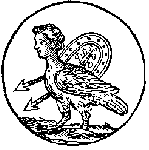 Naples’
ancient origins can be found in a series of legends, among which the most
meaningful is the one about Partenope, a mermaid. Feeling shattered by Ulysses, who
succeded in escaping the mermaids’ enchanting song by his sheer cunning, she
committed suicide. Her body was found aground on
the rocks of a small island called Megaride, where nowadays you can see Castel
dell’Ovo. According to a less legendary version, Partenope was a marvellous young
woman, the daughter of a Greek commander,
Eumelo Falevo who had left for Campania to found a colony. Partenope died in a ship-wreck so her name was
given to the new-born town. As we know from historical sources, Greek colonies arrived on
the Isle of Ischia (IX century B.C.) and
later moved to Cuma; the city of Partenope
was founded on the Isle of Megaride in the 6th
century B.C. At that time Megaride was a commercial port trading with its
motherland; later on it expanded to Mount Echia (Pizzofalcone) and took the structure of a
small urban town.
Naples’
ancient origins can be found in a series of legends, among which the most
meaningful is the one about Partenope, a mermaid. Feeling shattered by Ulysses, who
succeded in escaping the mermaids’ enchanting song by his sheer cunning, she
committed suicide. Her body was found aground on
the rocks of a small island called Megaride, where nowadays you can see Castel
dell’Ovo. According to a less legendary version, Partenope was a marvellous young
woman, the daughter of a Greek commander,
Eumelo Falevo who had left for Campania to found a colony. Partenope died in a ship-wreck so her name was
given to the new-born town. As we know from historical sources, Greek colonies arrived on
the Isle of Ischia (IX century B.C.) and
later moved to Cuma; the city of Partenope
was founded on the Isle of Megaride in the 6th
century B.C. At that time Megaride was a commercial port trading with its
motherland; later on it expanded to Mount Echia (Pizzofalcone) and took the structure of a
small urban town.
Greek-Roman Naples
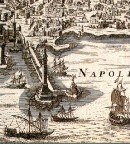 In 470 B.C. the Greek Cumaeans decided
to found a city and chose the eastest part of ancient Partenope, which is nowadays the
historical centre. They decided to call it "Neapolis" (new city) to be
distinguished from "Palepolis" (old city). At that time the city was probably an
aristocratic republic governed by two arcons and a council of nobles. From the point of
view of the urban structure, Neapolis was characterized by cards and decumans, according
to Greek tradition. The city was rich in religious and public buildings such as temples,
curia, theatres and hippodrome. It became an important Magna Grecia colony, together with
Taranto and Cuma. In the years to come, the Romans would be inspired by the culture, art
and traditions which enriched Neapolis in that period.
In 470 B.C. the Greek Cumaeans decided
to found a city and chose the eastest part of ancient Partenope, which is nowadays the
historical centre. They decided to call it "Neapolis" (new city) to be
distinguished from "Palepolis" (old city). At that time the city was probably an
aristocratic republic governed by two arcons and a council of nobles. From the point of
view of the urban structure, Neapolis was characterized by cards and decumans, according
to Greek tradition. The city was rich in religious and public buildings such as temples,
curia, theatres and hippodrome. It became an important Magna Grecia colony, together with
Taranto and Cuma. In the years to come, the Romans would be inspired by the culture, art
and traditions which enriched Neapolis in that period.
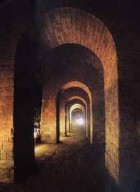 Although Neapolis was not a warlike city,
it had to defend itself from two notorious neighbours: the Samnites, who conquered Cuma in
423 B.C. and sent away its inhabitants, and the Romans, who were determined to expand
their dominiom in the south. At first the relationship between Rome and Neapolis was based on friendship and
commercial agreements but under the pressure of other colonies, Neapolis was forced not to
cooperate with the Romans any longer. In 326 B.C. the Roman Counsellor defeated the allied Samnites and Nola people. Peace
was not a dishonour since a confederation with Rome was created and Neapolis could keep
its istitutions and differencies. Years later Neapolis was a trusting ally of the more and
more powerful Romans. As a matter of fact
Neapolis was, to the Romans, an important means for Greek culture and civilization. Neapolis and
its surroundings became a privileged summer resort for Roman patricians, who built
luxurious villas between Puteoli and Sorrento. On
one hand Scipio the African, Silla, Tiberius, Caligola, Claudius, Nero, Brutus and
Lucullus chose these lands for simple relaxation and pleasure; on the other hand
Cicero, Horace, Pliny the Elder and Virgil found there inspiration to their artistic
genius. In other words Neapolis was a centre of sophisticated culture, a piece of Greece
in the Italian peninsula, always respected and admired by the Romans, who tried not to
oppress it or contaminate it.
Although Neapolis was not a warlike city,
it had to defend itself from two notorious neighbours: the Samnites, who conquered Cuma in
423 B.C. and sent away its inhabitants, and the Romans, who were determined to expand
their dominiom in the south. At first the relationship between Rome and Neapolis was based on friendship and
commercial agreements but under the pressure of other colonies, Neapolis was forced not to
cooperate with the Romans any longer. In 326 B.C. the Roman Counsellor defeated the allied Samnites and Nola people. Peace
was not a dishonour since a confederation with Rome was created and Neapolis could keep
its istitutions and differencies. Years later Neapolis was a trusting ally of the more and
more powerful Romans. As a matter of fact
Neapolis was, to the Romans, an important means for Greek culture and civilization. Neapolis and
its surroundings became a privileged summer resort for Roman patricians, who built
luxurious villas between Puteoli and Sorrento. On
one hand Scipio the African, Silla, Tiberius, Caligola, Claudius, Nero, Brutus and
Lucullus chose these lands for simple relaxation and pleasure; on the other hand
Cicero, Horace, Pliny the Elder and Virgil found there inspiration to their artistic
genius. In other words Neapolis was a centre of sophisticated culture, a piece of Greece
in the Italian peninsula, always respected and admired by the Romans, who tried not to
oppress it or contaminate it.
The Dukedom of Naples
In the early Middle Ages the history of Neapolis was
determined not only by the division of the Roman Empire but also by the invasion of
barbarian peoples and the fall of the Western Roman Empire (476 A.D.). In 536 Justinian,
Emperor of the East, sent Belisario in order to conquer the city, 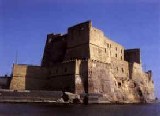 which
defended itself bravely. In 542 Naples was invaded by the Goths who definitely conquered
the Byzantine forces. Later on, the Byzantines reorganised themselves with Narsete and
took Naples once again as their dominion after a big battle at the foot of the volcano
Vesuvio, sending away the Goths from Campania. Under the undesired Byzantine domination,
Naples had to face the invasions of strong and uncivilized peoples i.e. the Vandals and
the Longobards. In 615 the attempt to gain independence brought about an independent
government which lasted for a short period of time. In 661 accepting a Neapolitan
petition, the Emperor of the East nominated Basilio, a Neapolitan duke, as head of the
city. In this way, even if it was still under Byzantium control, Naples had its own
government, which was at first nominated by the Byzantines, then elected before finally
becoming hereditary succession. Between 661 and 1137, after a period of difficult
struggle, Naples was one of the few oasis of civilization in the entire Italian peninsula,
surrounded by barbarian peoples
which
defended itself bravely. In 542 Naples was invaded by the Goths who definitely conquered
the Byzantine forces. Later on, the Byzantines reorganised themselves with Narsete and
took Naples once again as their dominion after a big battle at the foot of the volcano
Vesuvio, sending away the Goths from Campania. Under the undesired Byzantine domination,
Naples had to face the invasions of strong and uncivilized peoples i.e. the Vandals and
the Longobards. In 615 the attempt to gain independence brought about an independent
government which lasted for a short period of time. In 661 accepting a Neapolitan
petition, the Emperor of the East nominated Basilio, a Neapolitan duke, as head of the
city. In this way, even if it was still under Byzantium control, Naples had its own
government, which was at first nominated by the Byzantines, then elected before finally
becoming hereditary succession. Between 661 and 1137, after a period of difficult
struggle, Naples was one of the few oasis of civilization in the entire Italian peninsula,
surrounded by barbarian peoples
The Norman domination
During the
dukedom, Naples had to face the Longobards and the Saracens and sometimes asked for
mercenary help. Once called for help, the Normans were
given the feud of Aversa after withstanding Benevento
expansion. Under the Altavilla dynasty, however, the
Normans were no 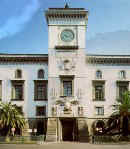 longer satisfied with what
they had and started a series of campaigns; they defeated the Arabs, conquered Sicily
and wanted to expand in the
South of Italy. Roger II occupied Salerno, Capri, Amalfi and Ravello. In 1137 making an
greement with Duke Sergious, he imposed his power on Naples. At the duke’s death,
Roger granted independence and elected a
supervisor; then he set off for Palermo. In
1154 William, known as Il Malo, succeeded Roger at his death. Despite his name – which
means “The Naughty”, “The Evil” – he was a wise and good king who
ordered the construction of Castel Capuano, contracted
alliances with the Maritime Republics and enjoyed Neapolitan aristocrats’ respect.
During his reign the history of Naples was closely tied to the history of Palermo. William
II, known as “Il Buono” –“The Good” – succeeded and ruled
wisely. At his death, in order not to let the reign fall into the hands of the Germans who
were pressing the bounderies, Tancredi d’Altavilla was called as his successor by an
assembly of nobles, prelates and representatives of the people. The Norman domination was
about to disappear since, after contrasting the Suevian siege in 1191, at Tancredi’s
death in 1194, the German sovereign Henry VI conquered the South of Italy.
longer satisfied with what
they had and started a series of campaigns; they defeated the Arabs, conquered Sicily
and wanted to expand in the
South of Italy. Roger II occupied Salerno, Capri, Amalfi and Ravello. In 1137 making an
greement with Duke Sergious, he imposed his power on Naples. At the duke’s death,
Roger granted independence and elected a
supervisor; then he set off for Palermo. In
1154 William, known as Il Malo, succeeded Roger at his death. Despite his name – which
means “The Naughty”, “The Evil” – he was a wise and good king who
ordered the construction of Castel Capuano, contracted
alliances with the Maritime Republics and enjoyed Neapolitan aristocrats’ respect.
During his reign the history of Naples was closely tied to the history of Palermo. William
II, known as “Il Buono” –“The Good” – succeeded and ruled
wisely. At his death, in order not to let the reign fall into the hands of the Germans who
were pressing the bounderies, Tancredi d’Altavilla was called as his successor by an
assembly of nobles, prelates and representatives of the people. The Norman domination was
about to disappear since, after contrasting the Suevian siege in 1191, at Tancredi’s
death in 1194, the German sovereign Henry VI conquered the South of Italy.
Naples under the Suevian
dominion
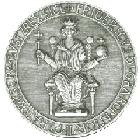 Henry
VI ruled Naples for three years which were not so happy for the city itself. He was
succeeded by Frederick II who is nowadays
considered one of the greatest sovereign ever ascended a
European throne. At first his relationship with the city was not easy; as a matter of fact
several attempts to subvert his reign were planned. But things improved and when he
visited the city in 1220 first and then in
1222, he was positively impressed and
promoted many works of embellishment and
restoration. He was a man of great culture who created
a strong centrally-organized power, rearranged
public administration, justice, trade and army. Not only did he successfully
impose himself in many military campaigns in Germany and Jerusalem, but he also promoted
culture and art, being surrounded by poets, philosophers and scholars.
Henry
VI ruled Naples for three years which were not so happy for the city itself. He was
succeeded by Frederick II who is nowadays
considered one of the greatest sovereign ever ascended a
European throne. At first his relationship with the city was not easy; as a matter of fact
several attempts to subvert his reign were planned. But things improved and when he
visited the city in 1220 first and then in
1222, he was positively impressed and
promoted many works of embellishment and
restoration. He was a man of great culture who created
a strong centrally-organized power, rearranged
public administration, justice, trade and army. Not only did he successfully
impose himself in many military campaigns in Germany and Jerusalem, but he also promoted
culture and art, being surrounded by poets, philosophers and scholars.
Angevin Naples
In
1266 the Pope himself asked Carlo d’Angiò, the brother of the king of France, to
come to Italy. He arrived, defeated Manfredi
in Benevento and became king of the South of Italy.The city became the capital of the
reign, despite strong protests from Sicily. Neapolitain society was rearranged in 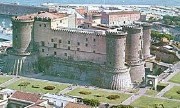 what were called Sedili, democratic intermediary organisms between
the sovereign and the people. Strong tax regulations didin’t prevent Naples from
developing into a city rich in marvellous churches, dignified factories and expanding craftmanship and trade. In this period
population increased enormously so that Naples became the first city in Italy and the
second in Europe after Paris. Nevertheless, the king had hard times to come when, in 1267,
he had to face a new attack from Corradino, who was beheaded in the bloom of youth in
Piazza Mercato after being defeated inTagliacozzo. In 1282 the Sicilian Vespers brought
about the loss of Sicily and two years later an
uprising supported by the guibellines was soffocated with the help of the local
aristocracy. At Carlo’s death in 1285, Carlo II came to the throne. He proved
to be a good legislator and improved
the artistic city wealth – we owe him the enlargement of the city walls, the
restructuring of Castel dell’Ovo and the
restyling of Maschio Angioino, built by his father. In 1309 another great king ascended
the throne of Naples:
what were called Sedili, democratic intermediary organisms between
the sovereign and the people. Strong tax regulations didin’t prevent Naples from
developing into a city rich in marvellous churches, dignified factories and expanding craftmanship and trade. In this period
population increased enormously so that Naples became the first city in Italy and the
second in Europe after Paris. Nevertheless, the king had hard times to come when, in 1267,
he had to face a new attack from Corradino, who was beheaded in the bloom of youth in
Piazza Mercato after being defeated inTagliacozzo. In 1282 the Sicilian Vespers brought
about the loss of Sicily and two years later an
uprising supported by the guibellines was soffocated with the help of the local
aristocracy. At Carlo’s death in 1285, Carlo II came to the throne. He proved
to be a good legislator and improved
the artistic city wealth – we owe him the enlargement of the city walls, the
restructuring of Castel dell’Ovo and the
restyling of Maschio Angioino, built by his father. In 1309 another great king ascended
the throne of Naples: 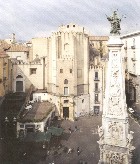 his name was
Roberto d’Angiò, known as the Wise, a
man of art and culture who was able to create a remarkable intellectual climate.
Boccaccio, Giotto, Petrarca and Tino da Camaino lived and worked in Naples at that time.
Roberto D’Angiò promoted legislative studies, ordered the construction of the Church
of S. Chiara – where we can find his funeral monument – and witnessed the
flourish of gothic style – churches of S. Lorenzo, S.
Paolo Maggiore, San Domenico Maggiore, Incoronata. At
his death in 1343 his niece Giovanna found herself in a series of terrible events - riots,
plague and Hungarian invasions - which
affected the city. She also caused some trouble with her frivolous and senseless
behaviour. After forty years of rule her nephew Carlo Durazzo d’Angiò, who was
considered very reliable and trustful by the
queen herself, murdered her and took the
throne. He died a few years later and the Durazzo family, a secondary descent of the
d’Angiòs, brought young Ladislao onto
the throne of Naples. Luigi II d’Angiò was very hostile to him since he claimed the
throne for himself. Despite the city division
into two factions, Ladislao succeded in taking control and ruled as a good king. In 1404
he conquered Rome in order to unify the peninsula but he had to abandon it in 1409. He
died at the age of forty and left the throne to his sister Giovanna who, like her ancestor
with the same name, was devoted to love affairs and scandals more than to queen’s
activities.
his name was
Roberto d’Angiò, known as the Wise, a
man of art and culture who was able to create a remarkable intellectual climate.
Boccaccio, Giotto, Petrarca and Tino da Camaino lived and worked in Naples at that time.
Roberto D’Angiò promoted legislative studies, ordered the construction of the Church
of S. Chiara – where we can find his funeral monument – and witnessed the
flourish of gothic style – churches of S. Lorenzo, S.
Paolo Maggiore, San Domenico Maggiore, Incoronata. At
his death in 1343 his niece Giovanna found herself in a series of terrible events - riots,
plague and Hungarian invasions - which
affected the city. She also caused some trouble with her frivolous and senseless
behaviour. After forty years of rule her nephew Carlo Durazzo d’Angiò, who was
considered very reliable and trustful by the
queen herself, murdered her and took the
throne. He died a few years later and the Durazzo family, a secondary descent of the
d’Angiòs, brought young Ladislao onto
the throne of Naples. Luigi II d’Angiò was very hostile to him since he claimed the
throne for himself. Despite the city division
into two factions, Ladislao succeded in taking control and ruled as a good king. In 1404
he conquered Rome in order to unify the peninsula but he had to abandon it in 1409. He
died at the age of forty and left the throne to his sister Giovanna who, like her ancestor
with the same name, was devoted to love affairs and scandals more than to queen’s
activities.
Naples under the
Aragoneses
A few years before dying, Giovanna Durazzo called for the
help of Alfonso d'Aragona, king of Sicily. He adopted her, this way justifying his right
to 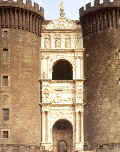 succession to the throne. Finally she changed her mind
and nominated Renato d'Angiò as her heir; as a consequence, the Aragonese sovereign felt
betrayed, put Naples under siege and conquered it in 1442. This was the beginning of the
Aragonese dominion which paved the way for a civil and economic development of the city
and the florishing of Renaissance art and ideals: artists such as Giovanni Pontano, Jacopo
Sannazaro, Pietro Summonte, Pietro Beccadelli and Lorenzo Valli could demonstrate their
talents thanks to the stimulating atmosphere created by Alfonso, who deserved the name of
Magnanimo (generous, high-minded). Grand monuments still remain as evidence of that
grandeur: the marble arch of Castel Nuovo - which the sovereign wanted so as to celebrate
the conquest of the city - , the church of S. Anna del Lombardi, the church of S. Angelo
al Nilo, great works which saw the contribution of Vasari and Donatello. In 1458 at
Alfonso's death the crown of Naples passed to his son Ferrante while Giovanni, another of
his sons, was given the crown of Sicily. Under Ferrante's reign, Naples
succession to the throne. Finally she changed her mind
and nominated Renato d'Angiò as her heir; as a consequence, the Aragonese sovereign felt
betrayed, put Naples under siege and conquered it in 1442. This was the beginning of the
Aragonese dominion which paved the way for a civil and economic development of the city
and the florishing of Renaissance art and ideals: artists such as Giovanni Pontano, Jacopo
Sannazaro, Pietro Summonte, Pietro Beccadelli and Lorenzo Valli could demonstrate their
talents thanks to the stimulating atmosphere created by Alfonso, who deserved the name of
Magnanimo (generous, high-minded). Grand monuments still remain as evidence of that
grandeur: the marble arch of Castel Nuovo - which the sovereign wanted so as to celebrate
the conquest of the city - , the church of S. Anna del Lombardi, the church of S. Angelo
al Nilo, great works which saw the contribution of Vasari and Donatello. In 1458 at
Alfonso's death the crown of Naples passed to his son Ferrante while Giovanni, another of
his sons, was given the crown of Sicily. Under Ferrante's reign, Naples 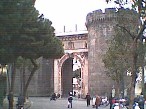 had to defend itself from Angevin claims - who were won at Sarno and in
Ischia during a naval battle - and from Florence in 1458. Several times the barons
conspired against Ferrante, despite the fact that he was a good king and a fine
legislator. During his reign the majestic Porta Capuana was built. When Ferrante died in
1493, Alfonso II ascended the throne but he soon abdicated in favour of his son,
Ferrantino, under the pressure of a likely French throne claim. In fact, Ferrantino wasn't
able to oppose Carlo VIII French army long and escaped to Ischia while the Angevins were
entering Naples. Only when Carlo went back to Paris and left behind few garrisons was he
able to enter the city again supported by the Neapolitan people. He died two years later,
mourned by the people. The crown passed to his uncle Frederick d'Altamura
had to defend itself from Angevin claims - who were won at Sarno and in
Ischia during a naval battle - and from Florence in 1458. Several times the barons
conspired against Ferrante, despite the fact that he was a good king and a fine
legislator. During his reign the majestic Porta Capuana was built. When Ferrante died in
1493, Alfonso II ascended the throne but he soon abdicated in favour of his son,
Ferrantino, under the pressure of a likely French throne claim. In fact, Ferrantino wasn't
able to oppose Carlo VIII French army long and escaped to Ischia while the Angevins were
entering Naples. Only when Carlo went back to Paris and left behind few garrisons was he
able to enter the city again supported by the Neapolitan people. He died two years later,
mourned by the people. The crown passed to his uncle Frederick d'Altamura
The Spanish
viceroyalty
With
the definition “Spanish viceroyalty” we refer to a period of almost two
centuries of colonialistic domination. Between 1503 and 1707 the crown of Madrid exerted
its power on Naples and the whole reign with eagerness as well as inability. 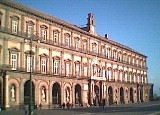 A host of viceroys took regency of the city
and proved to be devoted to vexations; they also stole works of art and imposed heavy
taxes. In this period in order to defend and
support the people from Spanish arrogance, a kind of secret society, called
“camorra”, was arranged; at first its aim was to offer mutual assistance. Lots
of insurrections and warlike events took place in those years: Venice’s possessions
in Puglia were occupied, the African expeditions to Tunisi and Tripoli –and the
victory in Lepanto- were carried out, the French invasion was pushed back in 1526 and
several Arab and Turkish pirate raids were faced. At home there were lots of uprisings due
to heavy taxes and attempts to introduce the
Inquisition. The most famous and daring one was in 1647 when Masaniello, the head of a
group of fierce people, hold the Spanish
A host of viceroys took regency of the city
and proved to be devoted to vexations; they also stole works of art and imposed heavy
taxes. In this period in order to defend and
support the people from Spanish arrogance, a kind of secret society, called
“camorra”, was arranged; at first its aim was to offer mutual assistance. Lots
of insurrections and warlike events took place in those years: Venice’s possessions
in Puglia were occupied, the African expeditions to Tunisi and Tripoli –and the
victory in Lepanto- were carried out, the French invasion was pushed back in 1526 and
several Arab and Turkish pirate raids were faced. At home there were lots of uprisings due
to heavy taxes and attempts to introduce the
Inquisition. The most famous and daring one was in 1647 when Masaniello, the head of a
group of fierce people, hold the Spanish 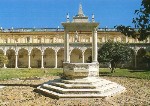 “masters”
in check for more than a year. They were finally defeated after the taking of their
headquarter in Castello del armine. From an artistic point of view, the city saw a group of great men of arts and
culture working and expressing their
talents: Tasso, Giovambattista Basile and Giambattista Marino in literature; Tommaso
Campanella, Giordano Bruno and Giambattista Vico in philosophy; Massimo Stanzione,
Battistello Caracciolo, Bernardo Cavallino, Salvator Rosa, Luca Giordano, Mattia Preti and
Andrea da Salerno in painting; Pietro Bernini, Michelangelo Naccherino, Giovanni da Nola
and Girolamo Santacroce in sculpure; Domenico Fontana and Cosimo Fanzago in architecture;
among some of the most important works we can still admire the Royal Palace, San Martino Certosa and the Church of Gesù
Nuovo.uovo.
“masters”
in check for more than a year. They were finally defeated after the taking of their
headquarter in Castello del armine. From an artistic point of view, the city saw a group of great men of arts and
culture working and expressing their
talents: Tasso, Giovambattista Basile and Giambattista Marino in literature; Tommaso
Campanella, Giordano Bruno and Giambattista Vico in philosophy; Massimo Stanzione,
Battistello Caracciolo, Bernardo Cavallino, Salvator Rosa, Luca Giordano, Mattia Preti and
Andrea da Salerno in painting; Pietro Bernini, Michelangelo Naccherino, Giovanni da Nola
and Girolamo Santacroce in sculpure; Domenico Fontana and Cosimo Fanzago in architecture;
among some of the most important works we can still admire the Royal Palace, San Martino Certosa and the Church of Gesù
Nuovo.uovo.
The Borbons

The French decade

The Borbons' return

Naples after
Unification

Contemporary Naples

Back to Home Page
 Naples’
ancient origins can be found in a series of legends, among which the most
meaningful is the one about Partenope, a mermaid. Feeling shattered by Ulysses, who
succeded in escaping the mermaids’ enchanting song by his sheer cunning, she
committed suicide. Her body was found aground on
the rocks of a small island called Megaride, where nowadays you can see Castel
dell’Ovo. According to a less legendary version, Partenope was a marvellous young
woman, the daughter of a Greek commander,
Eumelo Falevo who had left for Campania to found a colony. Partenope died in a ship-wreck so her name was
given to the new-born town. As we know from historical sources, Greek colonies arrived on
the Isle of Ischia (IX century B.C.) and
later moved to Cuma; the city of Partenope
was founded on the Isle of Megaride in the 6th
century B.C. At that time Megaride was a commercial port trading with its
motherland; later on it expanded to Mount Echia (Pizzofalcone) and took the structure of a
small urban town.
Naples’
ancient origins can be found in a series of legends, among which the most
meaningful is the one about Partenope, a mermaid. Feeling shattered by Ulysses, who
succeded in escaping the mermaids’ enchanting song by his sheer cunning, she
committed suicide. Her body was found aground on
the rocks of a small island called Megaride, where nowadays you can see Castel
dell’Ovo. According to a less legendary version, Partenope was a marvellous young
woman, the daughter of a Greek commander,
Eumelo Falevo who had left for Campania to found a colony. Partenope died in a ship-wreck so her name was
given to the new-born town. As we know from historical sources, Greek colonies arrived on
the Isle of Ischia (IX century B.C.) and
later moved to Cuma; the city of Partenope
was founded on the Isle of Megaride in the 6th
century B.C. At that time Megaride was a commercial port trading with its
motherland; later on it expanded to Mount Echia (Pizzofalcone) and took the structure of a
small urban town.  In 470 B.C. the Greek Cumaeans decided
to found a city and chose the eastest part of ancient Partenope, which is nowadays the
historical centre. They decided to call it "Neapolis" (new city) to be
distinguished from "Palepolis" (old city). At that time the city was probably an
aristocratic republic governed by two arcons and a council of nobles. From the point of
view of the urban structure, Neapolis was characterized by cards and decumans, according
to Greek tradition. The city was rich in religious and public buildings such as temples,
curia, theatres and hippodrome. It became an important Magna Grecia colony, together with
Taranto and Cuma. In the years to come, the Romans would be inspired by the culture, art
and traditions which enriched Neapolis in that period.
In 470 B.C. the Greek Cumaeans decided
to found a city and chose the eastest part of ancient Partenope, which is nowadays the
historical centre. They decided to call it "Neapolis" (new city) to be
distinguished from "Palepolis" (old city). At that time the city was probably an
aristocratic republic governed by two arcons and a council of nobles. From the point of
view of the urban structure, Neapolis was characterized by cards and decumans, according
to Greek tradition. The city was rich in religious and public buildings such as temples,
curia, theatres and hippodrome. It became an important Magna Grecia colony, together with
Taranto and Cuma. In the years to come, the Romans would be inspired by the culture, art
and traditions which enriched Neapolis in that period. 
 which
defended itself bravely. In 542 Naples was invaded by the Goths who definitely conquered
the Byzantine forces. Later on, the Byzantines reorganised themselves with Narsete and
took Naples once again as their dominion after a big battle at the foot of the volcano
Vesuvio, sending away the Goths from Campania. Under the undesired Byzantine domination,
Naples had to face the invasions of strong and uncivilized peoples i.e. the Vandals and
the Longobards. In 615 the attempt to gain independence brought about an independent
government which lasted for a short period of time. In 661 accepting a Neapolitan
petition, the Emperor of the East nominated Basilio, a Neapolitan duke, as head of the
city. In this way, even if it was still under Byzantium control, Naples had its own
government, which was at first nominated by the Byzantines, then elected before finally
becoming hereditary succession. Between 661 and 1137, after a period of difficult
struggle, Naples was one of the few oasis of civilization in the entire Italian peninsula,
surrounded by barbarian peoples
which
defended itself bravely. In 542 Naples was invaded by the Goths who definitely conquered
the Byzantine forces. Later on, the Byzantines reorganised themselves with Narsete and
took Naples once again as their dominion after a big battle at the foot of the volcano
Vesuvio, sending away the Goths from Campania. Under the undesired Byzantine domination,
Naples had to face the invasions of strong and uncivilized peoples i.e. the Vandals and
the Longobards. In 615 the attempt to gain independence brought about an independent
government which lasted for a short period of time. In 661 accepting a Neapolitan
petition, the Emperor of the East nominated Basilio, a Neapolitan duke, as head of the
city. In this way, even if it was still under Byzantium control, Naples had its own
government, which was at first nominated by the Byzantines, then elected before finally
becoming hereditary succession. Between 661 and 1137, after a period of difficult
struggle, Naples was one of the few oasis of civilization in the entire Italian peninsula,
surrounded by barbarian peoples



 succession to the throne. Finally she changed her mind
and nominated Renato d'Angiò as her heir; as a consequence, the Aragonese sovereign felt
betrayed, put Naples under siege and conquered it in 1442. This was the beginning of the
Aragonese dominion which paved the way for a civil and economic development of the city
and the florishing of Renaissance art and ideals: artists such as Giovanni Pontano, Jacopo
Sannazaro, Pietro Summonte, Pietro Beccadelli and Lorenzo Valli could demonstrate their
talents thanks to the stimulating atmosphere created by Alfonso, who deserved the name of
Magnanimo (generous, high-minded). Grand monuments still remain as evidence of that
grandeur: the marble arch of Castel Nuovo - which the sovereign wanted so as to celebrate
the conquest of the city - , the church of S. Anna del Lombardi, the church of S. Angelo
al Nilo, great works which saw the contribution of Vasari and Donatello. In 1458 at
Alfonso's death the crown of Naples passed to his son Ferrante while Giovanni, another of
his sons, was given the crown of Sicily. Under Ferrante's reign, Naples
succession to the throne. Finally she changed her mind
and nominated Renato d'Angiò as her heir; as a consequence, the Aragonese sovereign felt
betrayed, put Naples under siege and conquered it in 1442. This was the beginning of the
Aragonese dominion which paved the way for a civil and economic development of the city
and the florishing of Renaissance art and ideals: artists such as Giovanni Pontano, Jacopo
Sannazaro, Pietro Summonte, Pietro Beccadelli and Lorenzo Valli could demonstrate their
talents thanks to the stimulating atmosphere created by Alfonso, who deserved the name of
Magnanimo (generous, high-minded). Grand monuments still remain as evidence of that
grandeur: the marble arch of Castel Nuovo - which the sovereign wanted so as to celebrate
the conquest of the city - , the church of S. Anna del Lombardi, the church of S. Angelo
al Nilo, great works which saw the contribution of Vasari and Donatello. In 1458 at
Alfonso's death the crown of Naples passed to his son Ferrante while Giovanni, another of
his sons, was given the crown of Sicily. Under Ferrante's reign, Naples  had to defend itself from Angevin claims - who were won at Sarno and in
Ischia during a naval battle - and from Florence in 1458. Several times the barons
conspired against Ferrante, despite the fact that he was a good king and a fine
legislator. During his reign the majestic Porta Capuana was built. When Ferrante died in
1493, Alfonso II ascended the throne but he soon abdicated in favour of his son,
Ferrantino, under the pressure of a likely French throne claim. In fact, Ferrantino wasn't
able to oppose Carlo VIII French army long and escaped to Ischia while the Angevins were
entering Naples. Only when Carlo went back to Paris and left behind few garrisons was he
able to enter the city again supported by the Neapolitan people. He died two years later,
mourned by the people. The crown passed to his uncle Frederick d'Altamura
had to defend itself from Angevin claims - who were won at Sarno and in
Ischia during a naval battle - and from Florence in 1458. Several times the barons
conspired against Ferrante, despite the fact that he was a good king and a fine
legislator. During his reign the majestic Porta Capuana was built. When Ferrante died in
1493, Alfonso II ascended the throne but he soon abdicated in favour of his son,
Ferrantino, under the pressure of a likely French throne claim. In fact, Ferrantino wasn't
able to oppose Carlo VIII French army long and escaped to Ischia while the Angevins were
entering Naples. Only when Carlo went back to Paris and left behind few garrisons was he
able to enter the city again supported by the Neapolitan people. He died two years later,
mourned by the people. The crown passed to his uncle Frederick d'Altamura

